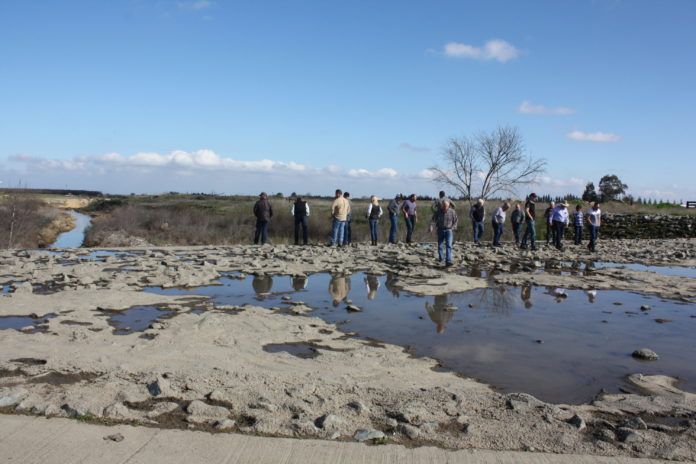 The San Luis Delta Mendota Water Authority held its board of directors meeting on Thursday, March 10, 2022 on Zoom from its Los Banos headquarters. I know I push the use of Zoom a lot although they are not a client of mine and no one’s asking me to do so. Zoom opens faster and if engaged by the presenter has better features. You can message everyone or just one participant at a time. You can raise a computer hand if you want to ask a question and there are probably a lot of other things you can do if you bother to take time and read the instructions. Not something I do much of.
The San Luis Delta Mendota Water Authority held its board of directors meeting on Thursday, March 10, 2022 on Zoom from its Los Banos headquarters. I know I push the use of Zoom a lot although they are not a client of mine and no one’s asking me to do so. Zoom opens faster and if engaged by the presenter has better features. You can message everyone or just one participant at a time. You can raise a computer hand if you want to ask a question and there are probably a lot of other things you can do if you bother to take time and read the instructions. Not something I do much of.
The Meeting
Chairman Cannon Michael called the meeting to order at 9:30am, right on schedule. Attorney Rebecca Akroyd called the role and during public comment I asked them to continue providing online access to the public even if it isn’t required by law. At more than $5 per gallon it would be helpful. Michael said it is certainly an important topic and one he’s confident the board will address.
The Consent Calendar was passed. Akroyd said four of the counties represented by SLDM have a larger than desired Covid infection rate and Item 7 was the resolution to continue meeting online until April 9th. She explained if Governor Gavin Newsom issues a proclamation between now and then that the emergency is over things will change. Although all the directors understand the importance of meeting in person they are also not dummies and don’t want to get sick. So they all agreed and passed the resolution.
Action Items
It was time to set the officers of the board and both Directors Gary Kremen of Santa Clara Valley Water District and Tom Birmingham of Westlands WD nominated holding the course and keeping Michael as Chair, William Bourdeau as Vice Chair and Executive Director Federico Barajas as Secretary. The board agreed they are all doing a good job and voted to keep them. Michael and Bourdeau both thanked the board for its confidence and pledged to keep up the pace during the race. My guess is Barajas was thankful too since it comes with his job. I least I think it does. Many entities are set up that way.
Akroyd then spoke about what members have to do to participate in the B.F. Sisk Dam raising and the expansion of the San Luis Reservoir. There is a resolution pending on this and it will be under the category of activity agreement. Under SLDM and other Joint Power Authorities activity agreements are a way for members to opt in and out of certain projects or activities. If a SLDM member wants to opt in there are benefits denied to those who opt out. However opting in will cost you. In this case opting in will give a member agency more storage space and it will have to pay a proportional share of the costs.
Akroyd outlined the proportional amounts and obligations and what happens if someone off ramps later. There were many other details. Del Puerto WD’s Anthea Hansen asked about the $1 million contribution by member districts to increase the storage by 130,000 a/f and wanted to know why investors are only getting 65,000 a/f. Barajas responded saying the US Bureau of Reclamation has a way to increase this amount by 20 percent. This is part of what is reimbursable and what isn’t. As I recall when the terms reimbursable and non-reimbursable are used in reference to what the government spending taxpayer money will pay and how much the taxpayer has to pay directly. In other words if a project the feds have a hand in is non-reimbursable that means the member agencies won’t have to pay that portion. If a cost is reimbursable the participating member will have to reimburse the feds for what they pay out.
Hansen’s concern was SLDM would pay 100 percent of the design and planning but only get half of the benefit. Jeff Cattaneo from San Benito County Water Authority said the $1 million will be covering other costs. I know that’s not a satisfactory explanation of Cattaneo’s comments but there is a large public document one can read for more information, Director Beau Correia Panoche WD asked if anyone knows how many members are going to opt in as that would be something his board would want to know before committing. The more members opting in shares the costs around and reduces what a member has to pay. Barajas said he will be doing outreach to the members and keep folks up to date as info comes in. The board approved the draft language of the agreement and passed the resolution.
Report Items
Barajas spoke about the SLDM strategic plan and said there are 11 items prioritized. Michael said he’s more than just impressed with staff’s ability to keep this plan alive by the effort and attention paid. He said often strategic plans are written and gather dust. In this case he advised the board to have a review to help staff with guidance.
Next former congressman and consultant/lobbyist Dennis Cardoza updated the board on federal matters. He said there was a contentious hearing on the bill put forth by former NRDC attorney who is now a Congressman, Jared Huffman that is a very concerning. The bill backed by all the right NGOs and is supposedly going to help salmon.
Cardoza said Senator Dianne Feinstein has a bill with hundreds of millions of taxpayer dollars for funding water supplies for disadvantaged communities. He also said Washington DC is starting to open up and there are more opportunities to meet in person there.
Bill Ball of Foley & Lardner next spoke saying Huffman’s bill was scheduled for another hearing as Cardoza spoke. He said one of the congressmen on the ag committee from Pennsylvania toured the San Joaquin Valley and now knows more about the impact of water policy. Ball said the takeaway for the congressman was the productive almond trees fallowed by lack of water. Ball also said the omnibus spending bill passed the House and the Senate should take it up soon. The USBR’s cut came in for a couple of billion of taxpayers’ dollars. His listed the further breakdown of funds and said he and Cardoza were able to carve out $5 million for the Delta Mendota Canal if I understood.
Cardoza said while Ball was talking there have been two House members who reached out to him over the Huffman bill and he urged everyone to reach out to their representatives as this could be devastating if passed. Let us all do this. Send an email, if you’re reading this you have a computer and I’m sure you have your elected officials’ email addresses and you regularly make your opinions know. Right?
Kristin Olsen next spoke about California legislative matters saying a bill to help with taxpayer funding for the Sites Reservoir and four canal repairs for $100 million didn’t pass. She said that was expected but it is only a skirmish and not the end of the battle. Olsen said there will be a newsletter centered on California water policy coming out soon. Olsen said the recent State of the State speech given by Gov Gav was the shortest he’s ever given at 18-minutes and didn’t include anything about the drought. Tomorrow is the deadline to move a spot bill to committee so there should be substantial language to review by next week. By April 29th all policy bills in both the assembly and state senate have to move out of committee. She said Sacramento has opened up some but it sounded like it was still masked and limited to the amount of folks allowed in meetings.
deadline to move a spot bill to committee so there should be substantial language to review by next week. By April 29th all policy bills in both the assembly and state senate have to move out of committee. She said Sacramento has opened up some but it sounded like it was still masked and limited to the amount of folks allowed in meetings.
Correia asked Olsen if she has a sense the elected officials are aware of the danger of reduced food supply. Olsen said those representing ag areas are but others not so much. Correia asked what could be done and she said developing data of dangerous food shortages is going to help. Cardoza said there is a growing awareness in Washington on this and pointed out Mike Wade’s California Farm Water Coalition has been helpful. Good for him.
Olsen said there is a blessing on the horizon in as much as Senators Melissa Hurtado and Anna Caballero won’t be running against each other. John Duarte of Duarte Nursery is running against incumbent Adam Grey and many are finding that puzzling.
Barajas gave his report saying the Delta Mendota Canal subsidence correction has had several meetings to keep it moving along. He asked Frances Mizuno to give an update on the San Luis Transmission Line project. The pumps, the interties and really all of the San Luis Division of the Central Valley Project uses a lot of power. The transmission lines need to be replaced and this is a major amount of work and expensive as you might imagine. Documents and partnerships are ongoing and her report sounded positive and optimistic.
Next Mizuno reported on water transfers. SLDM brings water from the Sacramento Valley south through the Delta to help make up for days like these when there is a zero allocation from the Bureau for South of Delta ag use. These transfers have many hurdles to jump through. The price goes up as the demand increases while the supplies shrink. There is a lot of buyer competition.
Barajas said there are a number of scoping sessions taking place on the biological opinions for Delta operations. He also said the State Board is having a workshop next week about oversight. The State Water Resources Out of Control Board (I just like writing that) is under criticism like most entities are during drought. But they are not an accountable body. To the last they are appointed by the governor.
Barajas said Joyce Machado who has been a constant at SLDM, she runs the accounting there, is moving on. She’ll be at San Benito County WA. Good for them. Machado has answered a lot my questionable questions with grace and kindness. She gave a moving goodbye. Michael and Barajas thanked her for her good work.
COO Report
Pablo Arroyave gave the water report saying things are not looking hunky dory with Shasta at 50 percent. Folsom Reservoir is doing the best for storage. Only one pump at the Jones plant has been running and there is less than 50,000 a/f of supplies on the federal side of San Luis Reservoir. He said the Bureau’s Fresno office has shared with Friant there may be a call on San Joaquin River water to meet Exchange Contractor’s supplies.
Other Reports
Wade said he’s working on the California Ag Water Update and it will be a quarterly report on policy impacts on farm water. He’s working with Bob Reeb at the Valley Water Alliance on this project and the next report should come out soon. Its targeted demographic is elected officials in Sacramento and Washington. Wade said the Collaborative Action Plan is moving along and he’s heard encouraging things from the ag caucus. He’s also working with the Farm Water Alliance on some presentations.
on this project and the next report should come out soon. Its targeted demographic is elected officials in Sacramento and Washington. Wade said the Collaborative Action Plan is moving along and he’s heard encouraging things from the ag caucus. He’s also working with the Farm Water Alliance on some presentations.
Board Member Reports
They were shy and no one spoke up. With that Michael ushered folks into closed session at 11:05am. I counted about 21 items or issues listed for the closed session agenda. On the subject of closed session. Public meetings need to be public but there are somethings that can be discussed internally by boards without the public. Rarer than a pearl in an oyster are the matters discussed in closed session earthshattering. I’ve sat through a few in the past and for the most part I’m glad I don’t have to. A few things get me curious but under the Ralph M. Brown Act in California a public agency can adjourn to closed session to discuss lawsuits and legal strategy, personnel issues and real property negotiations. Any actions taken have to be reported. There is a lot of governmental actions and policy I think are hostile to the governed but the Brown Act is also as rare as a pearl in an oyster – a common sense law from Sacramento. However, take into account it was passed in 1953.
are the matters discussed in closed session earthshattering. I’ve sat through a few in the past and for the most part I’m glad I don’t have to. A few things get me curious but under the Ralph M. Brown Act in California a public agency can adjourn to closed session to discuss lawsuits and legal strategy, personnel issues and real property negotiations. Any actions taken have to be reported. There is a lot of governmental actions and policy I think are hostile to the governed but the Brown Act is also as rare as a pearl in an oyster – a common sense law from Sacramento. However, take into account it was passed in 1953.
DISCLAIMER OF RESPONSIBILITY; Waterwrights strives to provide clients with the most complete, up-to-date, and accurate information available. Nevertheless, Waterwrights does not serve as a guarantor of the accuracy or completeness of the information provided, and specifically disclaims any and all responsibility for information that is not accurate, up-to-date, or complete. Waterwrights’ clients therefore rely on the accuracy, completeness and timeliness of information from DAW entirely at their own risk. The opinions expressed in this report are those of the author and do not represent any advertisers or third parties.
ALL RIGHTS RESERVED. Copyright 2022 by WaterWrights.net/DAW
SAN LUIS & DELTA-MENDOTA WATER AUTHORITY was established in January of 1992 and consists of approximately 2,100,000 acres of 29 federal and exchange water service contractors within the western San Joaquin Valley, San Benito and Santa Clara counties. The governing body of the Authority consists of a 19-member Board of Directors classified into five divisions with directors selected from within each division. The main conveyance is the Delta-Mendota Canal that delivers approximately 3,000,000-acre feet of water within the Authority service area. Of this amount, 2,500,000-acre feet are delivered to highly productive agricultural lands, 150,000 to 200,000-acre feet for municipal and industrial uses, and between 250,000 to 300,000 acre-feet are delivered to wildlife refuges for habitat enhancement and restoration.
Board – Chairman: Cannon Michael,
Staff – Executive Director: Federico Barajas, COO: Pablo Arroyave, Attorney: Becca Ackroyd, Director of Water Policy: J. Scott Pedersen
Email: youtellus@sldmwa.org 209/826-9696
P.O. Box 2157 Los Banos, CA. 93635

































